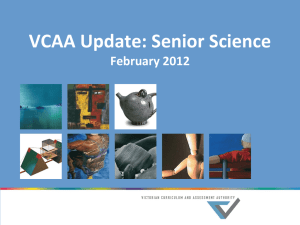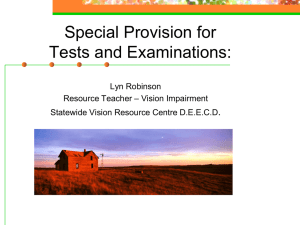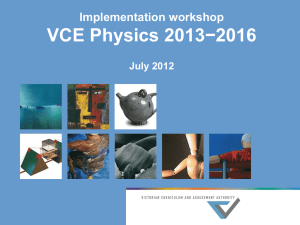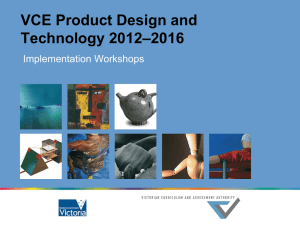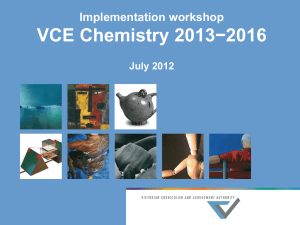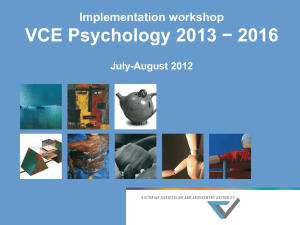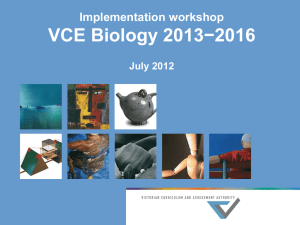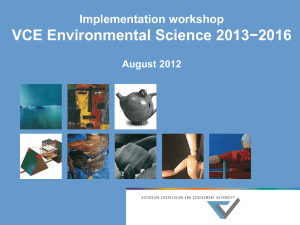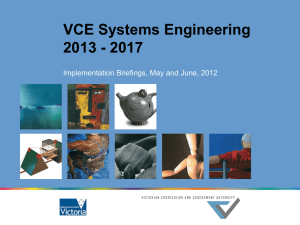VCE Food and Technology Assessment Handbook 2011-2016
advertisement
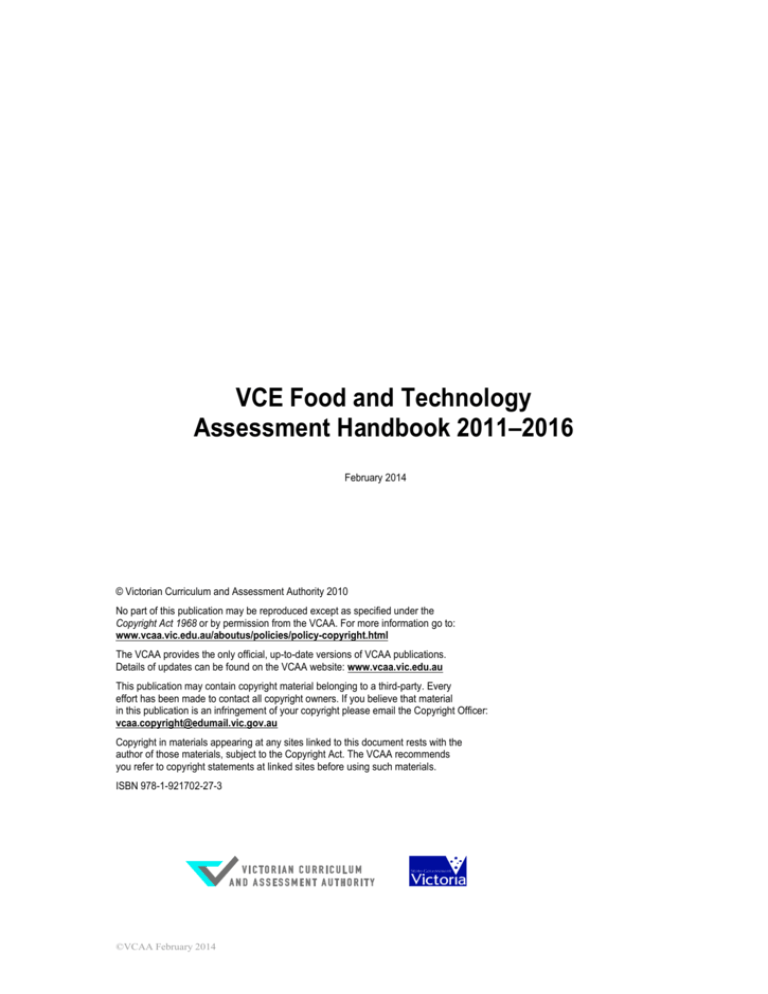
VCE Food and Technology Assessment Handbook 2011–2016 February 2014 © Victorian Curriculum and Assessment Authority 2010 No part of this publication may be reproduced except as specified under the Copyright Act 1968 or by permission from the VCAA. For more information go to: www.vcaa.vic.edu.au/aboutus/policies/policy-copyright.html The VCAA provides the only official, up-to-date versions of VCAA publications. Details of updates can be found on the VCAA website: www.vcaa.vic.edu.au This publication may contain copyright material belonging to a third-party. Every effort has been made to contact all copyright owners. If you believe that material in this publication is an infringement of your copyright please email the Copyright Officer: vcaa.copyright@edumail.vic.gov.au Copyright in materials appearing at any sites linked to this document rests with the author of those materials, subject to the Copyright Act. The VCAA recommends you refer to copyright statements at linked sites before using such materials. ISBN 978-1-921702-27-3 ©VCAA February 2014 Contents Introduction ..........................................................................................................................................3 Assessment ..........................................................................................................................................4 VCE assessment principles ........................................................................................................4 School-assessed Coursework ....................................................................................................6 Scope of tasks ................................................................................................................7 Designing the assessment tasks ....................................................................................7 Making assessment part of teaching and learning .........................................................7 Food and Technology Assessment Advice and Further Resources ...............................................9 School-assessed Coursework ....................................................................................................9 Unit 3 Performance descriptors ......................................................................................9 Unit 4 Performance descriptors ....................................................................................13 School-assessed Task .............................................................................................................15 Sample approaches to School-assessed Coursework .............................................................16 Unit 3 ............................................................................................................................16 Unit 4 ............................................................................................................................18 Further Resources ....................................................................................................................21 Examination ..................................................................................................................21 Publications ..................................................................................................................22 ©VCAA, February 2014 VCE Food and Technology ASSESSMENT HANDBOOK 2011–2016 Introduction The VCE Food and Technology Assessment Handbook 2011–2016 contains assessment information for both school-based assessment and the examination in Food and Technology and advice for teachers on how to construct assessment tasks. Advice on matters related to the administration of VCE assessment is published annually in the VCE and VCAL Administrative Handbook. Updates to matters related to the administration of VCE assessment are published in the VCAA Bulletin VCE, VCAL and VET. Teachers must refer to these publications for current advice. Units 1 and 2 In Food and Technology the student’s level of achievement in Units 1 and 2 is a matter for school decision. Assessment of levels of achievement for these units will not be reported to the Victorian Curriculum and Assessment Authority (VCAA). Schools may choose to report levels of achievement using grades, descriptive statements or other indicators. Units 3 and 4 The VCAA will supervise the assessment of all students undertaking Units 3 and 4. In Food and Technology the student’s level of achievement will be determined by School-assessed Coursework, the School-assessed Task, and an end-of-year examination. The VCAA will report the student’s level of performance on each of three Graded Assessment components: Units 3 and 4 School-assessed Coursework, Units 3 and 4 School-assessed Task and the end-of-year examination as a grade from A+ to E or UG (ungraded). This assessment handbook is published in online format only and provides advice specifically for Units 3 and 4. Updates to the online assessment handbook are published in the VCAA Bulletin VCE, VCAL and VET. Teachers are advised that there may be minor errors in the contents page due to software version differences. ©VCAA February 2014 3 ASSESSMENT HANDBOOK 2011–2016 VCE Food and Technology Assessment VCE assessment principles Assessment is an integral part of teaching and learning that, at the senior secondary level: identifies opportunities for further learning describes student achievement articulates and maintains standards provides the basis for the award of a certificate. As part of VCE studies, assessment tasks enable: the demonstration of the achievement of an outcome or set of outcomes judgment and reporting of a level of achievement on a task or collection of tasks for School-assessed Coursework, School-assessed Tasks or examinations. Monitoring the results of VCE assessment also provides feedback that informs curriculum implementation, assessment design and curriculum review. In each VCE study, teachers and schools determine the assessment tasks to be used at Units 1 and 2. In Units 3 and 4, specified assessment tasks are set. At the Units 3 and 4 level of a VCE study, School-assessed Coursework, Schoolassessed Tasks and examinations provide assessment results that are used in the calculation of a student’s study score. The following are the principles that underpin all VCE assessment practices. These are extracted from the VCAA Principles and guidelines for the development and review of VCE Studies. VCE assessment will be valid This means that it will enable judgments to be made about demonstration of the outcomes and levels of achievement on assessment tasks fairly, in a balanced way and without adverse effects on the curriculum or for the education system. The overarching concept of validity is elaborated as follows. VCE assessment should be fair and reasonable Assessment should be acceptable to stakeholders – including students, schools, government and the community. The system for assessing the progress and achievement of students must be accessible, effective, equitable, reasonable and transparent. 4 ©VCAA February 2014 VCE Food and Technology ASSESSMENT HANDBOOK 2011–2016 Assessment instruments should not assess learning that is outside the scope of a study design. Each assessment instrument (for example, examination, assignment, test, project, practical, oral, performance, portfolio, presentation or observational schedule) should give students clear instructions. It should be administered under conditions (degree of supervision, access to resources, notice and duration) that are substantially the same for all students undertaking that assessment. VCE assessment should be equitable Assessment instruments should neither privilege nor disadvantage certain groups of students or exclude others on the basis of gender, culture, linguistic background, physical disability, socioeconomic status and geographical location. Assessment instruments should be designed so that, under the same or similar conditions, they provide consistent information about student performance. This may be the case when, for example, alternatives are offered at the same time for assessment of an outcome (which could be based on a choice of context) or at a different time due to a student’s absence. VCE assessment will be balanced The set of assessment instruments used in a VCE study will be designed to provide a range of opportunities for a student to demonstrate in different contexts and modes the knowledge, skills, understanding and capacities set out in the curriculum. This assessment will also provide the opportunity for students to demonstrate different levels of achievement specified by suitable criteria, descriptors, rubrics or marking schemes. Judgment about student level of achievement should be based on the results from a variety of practical and theoretical situations and contexts relevant to a study. Students may be required to respond in written, oral, performance, product, folio, multimedia or other suitable modes as applicable to the distinctive nature of a study or group of related studies. VCE assessment will be efficient The minimum number of assessments for teachers and assessors to make a robust judgment about each student’s progress and learning will be set out in the study design. Each assessment instrument must balance the demands of precision with those of efficiency. Assessment should not generate workload and/or stress that unduly diminish the performance of students under fair and reasonable circumstances. ©VCAA February 2014 5 ASSESSMENT HANDBOOK 2011–2016 VCE Food and Technology School-assessed Coursework School-assessed Coursework provides schools with the opportunity to make their own administrative arrangements for the internal assessment of their students. School-assessed Coursework also provides teachers with the opportunity to: select from the range of designated assessment tasks in the study design develop and administer their own assessment program for their students monitor the progress and work of their students provide important feedback to the student gather information about the teaching program. Students should know in advance how and when they are going to be assessed and the conditions under which they will be assessed. Assessment tasks should be part of the teaching and learning program. For each assessment task students should be provided with the: type of assessment task and approximate date for completion time allowed for the task allocation of marks nature of any materials they can utilise when completing the task opportunity to demonstrate the highest level of performance. Following an assessment task: teachers can use the performance of their students to evaluate the teaching and learning program a topic may need to be carefully revised again prior to the end of the unit to ensure students fully understand the key knowledge and skills required in preparation for the examination. Feedback provides students with important advice about which aspect or aspects of the key knowledge they need to learn and in which key skills they need more practice. Authentication Teachers should have in place strategies for ensuring that work submitted for assessment is the student’s own work. Where aspects of School-assessed Coursework tasks are completed outside class time teachers must monitor and record each student’s progress through to completion. This requires regular sightings of the work by the teacher and the keeping of records. The teacher may consider it appropriate to ask the student to demonstrate his/her understanding of the task at the time of submission of the work. If any part or all of the work cannot be authenticated, then the matter should be dealt with as a breach of rules. To reduce the possibility of authentication problems arising, or being difficult to resolve, the following strategies are useful: Ensure that a significant amount of classroom time is spent on the task so that the teacher is familiar with each student’s work and can regularly monitor and discuss aspects of the work with the student. Ensure that students document the specific stages of the development of work, starting with an early part of the task such as topic choice, list of resources and/or preliminary research. 6 ©VCAA February 2014 VCE Food and Technology ASSESSMENT HANDBOOK 2011–2016 Filing of copies of each students work at given stages in its development. Regular rotation of topics from year to year to ensure that students are unable to use student work from the previous year. Where there is more than one class of a particular study in the school, the VCAA expects the school to apply internal moderation/cross-marking procedures to ensure consistency of assessment between teachers. Teachers are advised to apply the same approach to authentication and record-keeping, as cross-marking sometimes reveals possible breaches of authentication. Early liaison on topics, and sharing of draft student work between teachers, enables earlier identification of possible authentication problems and the implementation of appropriate action. Encourage students to acknowledge tutors, if they have them, and to discuss and show the work done with tutors. Ideally, liaison between the class teacher and the tutor can provide the maximum benefit for the student and ensure that the tutor is aware of the authentication requirements. Similar advice applies if students receive regular help from a family member. Scope of tasks Assessment tasks must be a part of the regular teaching and learning program and must not unduly add to the workload associated with that program. They must be completed mainly in class and within a limited timeframe. Where optional assessment tasks are used, teachers must ensure that they are comparable in scope and demand. Teachers should select a variety of assessment tasks for their program to reflect the key knowledge and key skills being assessed and to provide for different learning styles. Designing the assessment tasks Designing an assessment task is an important part of the teaching, learning and assessment process. The assessment task needs to provide the opportunity for all students to demonstrate the highest level of performance on the outcome. Teachers should design an assessment task that is representative of the content (key knowledge and skills underpinning the outcome). Performance descriptors for each outcome in Units 3 and 4 are provided to assist teachers in making a judgment about the student’s level of performance on the outcome. The following information presents one approach to developing an assessment task. Making assessment part of teaching and learning Step 1: Define the parameters of an outcome and its related assessment task options This involves: Listing the key knowledge and skills that will be assessed by the outcome. These are stated in the study design but you may wish to reword them for student purposes. Choosing the assessment task from the options listed in the study design. It is possible for students in the same class to undertake different options; however, teachers must ensure that the tasks are comparable in scope and demand. Step 2: Examine the assessment advice Examine the highest level of performance descriptors and clarify their meaning if you are unsure. Use the study design as your reference point. Remember the performance descriptors for each outcome identify the qualities or characteristics that ©VCAA February 2014 7 ASSESSMENT HANDBOOK 2011–2016 VCE Food and Technology you are looking for in a student response. This helps in the development of the task. It also helps clarify what needs to be taught as well as what needs to be included in the assessment task. It will assist students in understanding the expectations of the task. Step 3: Determine teaching and learning activities Identify the nature and sequence of teaching and learning activities to cover the key knowledge and skills outlined in the study design. It is important that a variety of learning opportunities are provided to cater for individual preferred learning styles. (Refer to the ‘Advice for teachers’ section of the study design for some specific examples of learning activities for each outcome.) Step 4: Design the assessment task Try to use a range of task types across Units 3 and 4. The information in the stimulus should be relevant to the task and assist students in their response. Check that the instructions are clear. Are they complete and unambiguous? Conditions for the task It is important that students know what is expected of them in an assessment task. This means providing students with advice about the outcome’s key knowledge and skills to be assessed. This allows students to understand during the teaching and learning stage what they are expected to know or do. Students should be provided with the performance descriptors by which their response will be assessed. Students should be advised about the conditions under which they will be expected to do the task. Teachers can develop their own rules, consistent with school policies, about the material that can be brought into the room and the use of textbooks. Make sure that these rules are given to the students before the task is started and preferably in writing. One method of authentication is to collect the work at the end of each period and keep it in an individual plastic folder or workbook. Points to consider When constructing a task you will need to consider the following: Does the task enable students to demonstrate the highest possible performance level? Will students select the form of the response or will you select the form that the whole class will use? Will the task be completed in one lesson or over several lessons? If the task is going to run over several lessons will you divide the task into parts or collect students’ work at the end of each lesson? If your school has multiple Food and Technology classes and your task is designed to last several lessons will you slightly alter the task for each class? Does the task allow you to easily identify the key aspects of the response to be assessed? 8 ©VCAA February 2014 VCE Food and Technology ASSESSMENT HANDBOOK 2011–2016 Food and Technology Assessment Advice and Further Resources School-assessed Coursework Teachers will provide to the VCAA a score for each outcome in each of Units 3 and 4, which represents an assessment of the student’s achievement. The score must be based on the teacher’s assessment of the level of performance of each student on the outcomes for the unit specified in the study design. Teachers must select assessment tasks from the designated list for each outcome published in the study design. Assessment tasks should be a part of the regular teaching and learning program and should not add unduly to student workload. Assessment tasks should be completed mainly in class and within a limited timeframe. The overall assessment program for the unit should include a variety of assessment task formats, include provision for authentication of student work and take into account the overall workload for students. School-assessed Coursework for the outcomes in Unit 3 will contribute 18 per cent to the student’s study score for Food and Technology. School-assessed Coursework for the outcomes in Unit 4 will contribute 12 per cent to the student’s study score for Food and Technology. Performance descriptors Performance descriptors provide holistic statements of achievement developed from the outcome statement and its key knowledge and skills, as specified in the study design. They provide guidance for the setting and marking of assessment tasks. Unit 3 Area of Study 1 Outcome 1 Explain the roles and responsibilities of and the relationship between national, state and local authorities in ensuring and maintaining food safety within Australia. This outcome will contribute 20 marks out of 60 marks allocated to Schoolassessed Coursework for Unit 3. It will be assessed by one or more tasks, which will contribute a total of 20 marks. Performance descriptors The following descriptors provide a guide to the levels of performance typically demonstrated within each range on the assessment task/s. ©VCAA February 2014 9 ASSESSMENT HANDBOOK 2011–2016 VCE Food and Technology MARK RANGE DESCRIPTOR: typical performance in each range 16–20 marks Comprehensive description of the causes of food spoilage and food poisoning, and the practices used to prevent them. A very detailed explanation of the roles and responsibilities of and relationship between national, state and local authorities in ensuring a safe food supply. Very thorough identification and justification of the information required on a food label according to the Food Standards Code. A very clear explanation of the purpose of and the steps in the Hazard Analysis and Critical Control Points (HACCP) system including corrective actions. 12–15 marks Clearly stated and detailed description of the causes of food spoilage and food poisoning, and the practices used to prevent them. A detailed explanation of the roles and responsibilities of and relationship between national, state and local authorities in ensuring a safe food supply. Thorough identification and justification of the information required on a food label according to the Food Standards Code. A clear explanation of the purpose of and the steps in the HACCP system including corrective actions. 9–11 marks A clear description of the causes of food spoilage and food poisoning, and the practices used to prevent them. Satisfactory explanation of the roles and responsibilities of and relationship between national, state and local authorities in ensuring a safe food supply. A suitable identification and justification of some of the information required on a food label according to the Food Standards Code. A satisfactory explanation of the purpose of and the steps in the HACCP system and some feasible corrective actions that can be taken. 6–8 marks Brief description of the causes of food spoilage and food poisoning, and the practices used to prevent them. A basic explanation of the roles and responsibilities of and relationship between national, state and local authorities in ensuring a safe food supply. Basic knowledge demonstrated of the main information required on a food label according to the Food Standards Code. A brief explanation of the purpose of and the steps in the HACCP system and some identification of corrective actions that can be taken. 1–5 marks Limited knowledge demonstrated of the causes of food spoilage and food poisoning and the practices used to prevent them. Little explanation of the roles and responsibilities of national, state, and local authorities in ensuring a safe food supply. Limited knowledge demonstrated of the main information required on a food label according to the Food Standards Code. Some identification of the purpose of and the steps in the HACCP system. Task/s Description Any one or combination of the following: a report (oral, short written) a multimedia presentation a test (short and/or extended answer) an annotated visual display 10 ©VCAA February 2014 VCE Food and Technology ASSESSMENT HANDBOOK 2011–2016 a case study a media analysis. Designing the assessment task/s Teachers should develop assessment task/s that allow the student to: describe causes of and safety and hygiene practices to prevent food spoilage and food poisoning explain the roles and responsibilities of and relationship between, national, state and local authorities in ensuring a safe food supply identify and justify the information on a food label according to the Food Standards Code explain the purpose of and steps in the HACCP system and corrective actions for identified risks and hazards have the opportunity to demonstrate the highest level of performance. Resources and scheduling Schools may determine the conditions for the task including access to resources and notes. Students should be advised of the timeline and conditions under which the task is to be conducted. Unit 3 Area of Study 2 Outcome 2 Analyse preparation, processing and preservation techniques for key foods, and prepare foods safely and hygienically using these techniques. This outcome will contribute 40 marks out of 60 marks allocated to Schoolassessed Coursework for Unit 3. It will be assessed by one or more tasks, which will contribute a total of 40 marks. Performance descriptors The following descriptors provide a guide to the levels of performance typically demonstrated within each range on the assessment task/s. MARK RANGE DESCRIPTOR: typical performance in each range 32–40 marks Comprehensive description of the stages in and very detailed analysis of the reasons for primary and secondary processing of key foods. Very detailed knowledge of the physical, sensory and chemical properties of key foods and safe and hygienic application of preparation techniques that utilise these properties. Very thorough analysis of the functions of the natural components of key foods and their impact on food preparation and processing. Very detailed justification of the use of particular cooking techniques for key foods. A very clear understanding of a range of food preservation techniques. 24–31 marks Detailed description of the stages in and detailed analysis of the reasons for primary and secondary processing of key foods. Detailed knowledge of the physical, sensory and chemical properties of key foods and safe and hygienic application of preparation techniques that utilise these properties. Thorough analysis of the functions of the natural components of key foods and their impact on food preparation and processing. Detailed justification of the use of particular cooking techniques for key foods. A clear understanding of a range of food preservation ©VCAA February 2014 11 ASSESSMENT HANDBOOK 2011–2016 VCE Food and Technology techniques. 17–23 marks Satisfactory description of the steps in and limited analysis of the reasons for primary and secondary processing of key foods. Adequate knowledge of the physical, sensory and chemical properties of key foods and safe and hygienic application of preparation techniques that utilise these properties. Clearly stated analysis of the functions of the natural components of key foods and their impact on food preparation and processing. Sound justification of the use of particular cooking techniques for key foods. General understanding of a range of food preservation techniques 9–16 marks Limited description of the stages in and reasons for primary and secondary processing of key foods. Some knowledge of the physical, sensory and/or chemical properties of key foods and safe and hygienic application of preparation techniques that utilise these properties. Some understanding of the functions of the natural components of key foods and limited reference to their impact on food preparation and processing. Some justification of the use of particular cooking techniques for key foods. Limited understanding of a range of food preservation techniques. 0–8 marks Very brief description of the stages in and the reasons for primary and/or secondary processing of key foods. Limited knowledge of the physical, sensory and/or chemical properties of key foods and safe and hygienic application of preparation techniques that utilise these properties. Very basic understanding of the functions of the natural components of key foods and very limited reference to their impact on food preparation and processing. Some explanation of the use of particular cooking techniques for key foods. Very limited understanding of a range of food preservation techniques. Task/s Description Any one or combination of the following: production activities a report (oral, short written) a multimedia presentation an essay a test an annotated visual display a production portfolio online publication/communication (for example, blog/wiki/website). Designing the assessment task/s Teachers should develop assessment task/s that allow the student to: describe the stages in and analyse the reasons for primary and secondary processing of key foods demonstrate a knowledge of the physical, sensory and chemical properties of key foods and safely and hygienically prepare foods that utilise these properties in the production process 12 ©VCAA February 2014 VCE Food and Technology ASSESSMENT HANDBOOK 2011–2016 analyse the functions of the natural components of key foods and their impact on food preparation and processing justify the use of particular cooking techniques for key foods demonstrate understanding of a range of food preservation techniques have the opportunity to demonstrate the highest level of performance. Resources and scheduling Schools may determine the conditions for the task including access to resources and notes. Students should be advised of the timeline and conditions under which the task is to be conducted. Unit 4 Area of Study 2 Outcome 2 Analyse driving forces related to food product development, analyse new and emerging food products, and explain processes involved in the development and marketing of food products. This outcome will contribute 40 marks out of the 40 marks allocated to Schoolassessed Coursework for Unit 4. It will be assessed by one or more tasks, which will contribute a total of 40 marks. Performance descriptors The following descriptors provide a guide to the levels of performance typically demonstrated within each range on the assessment task/s. MARK RANGE DESCRIPTOR: typical performance in each range 32–40 marks Comprehensive analysis of environmental issues in food production, manufacturing and packaging. A very clear identification of the driving forces for development of new and emerging food products. A very detailed description of the role of each aspect of the process of food product development. A very thorough explanation of innovations and emerging technologies in, and analysis of the types of, food product development. A very clear explanation of the purposes of packaging and description of packaging systems. A comprehensive evaluation of marketing strategies for food products. 24–31 marks Detailed analysis of environmental issues in food production, manufacturing and packaging. A clear identification of the driving forces for development of new and emerging food products. A detailed description of the role of each aspect of the process of food product development. A thorough explanation of innovations and emerging technologies in food product development. A clear explanation of the purposes of packaging and description of packaging systems. A detailed evaluation of marketing strategies for food products. 17–23 marks Sound attempt at analysis of environmental issues in food production, manufacturing and packaging. Satisfactory identification of the driving forces for development of new and emerging food products. An adequate description of the role of each aspect of the process of food product development. Satisfactory description of innovations and emerging technologies in food product development. A basic explanation of the purposes of packaging and description of packaging systems. A clear description of marketing strategies for food products. 9–16 marks Limited explanation of environmental issues in food production, manufacturing and packaging. Limited identification of the driving ©VCAA February 2014 13 ASSESSMENT HANDBOOK 2011–2016 VCE Food and Technology forces for development of new and emerging food products. A limited description of the role of each aspect of the process of food product development. Some attempt to describe innovations and emerging technologies in food product development. A brief explanation of the purposes of packaging and description of packaging systems. A brief description of marketing strategies for food products. 0–8 marks Very limited explanation of environmental issues in food production, manufacturing and packaging. A very limited identification of the driving forces for development of new and emerging food products. A very brief description of the role of each aspect of the process of food product development. Limited identification of innovations and new technologies in food product development. A very brief explanation of the purposes of packaging and/or description of packaging systems. A very brief explanation of marketing strategies for food products. Task/s Description Any one or combination of the following: a test (short and/or extended response) a written report analysis of a case study structured questions a multimedia presentation an oral presentation. Designing the assessment task/s Teachers should develop assessment task/s that allow the student to: analyse environmental issues in food production and reasons for the adoption of more sustainable farming practices identify the driving forces related to the development of new and emerging food products describe the food product development process and the role of each aspect of the process analyse the types of food product development explain innovations and emerging technologies in food product development explain the purposes of packaging and describe packaging systems describe environmental issues associated with food manufacturing and packaging evaluate marketing strategies for food products have the opportunity to demonstrate the highest level of performance. Resources and scheduling Schools may determine the conditions for the task including access to resources and notes. Students should be advised of the timeline and conditions under which the task is to be conducted. 14 ©VCAA February 2014 VCE Food and Technology ASSESSMENT HANDBOOK 2011–2016 School-assessed Task Units 3 and 4 The School-assessed Task contributes 40 per cent to the study score and is commenced in Unit 3 and completed in Unit 4. Outcomes School-assessed Task Unit 3 Outcome 3 Develop a design brief, evaluation criteria and a design plan for the development of a food product. A design folio that includes: A design brief and Evaluation criteria and A design plan including: Research and ideas and An outline of food items, properties of main ingredients, processes, tools and equipment, safety and hygiene requirements to produce food items and An overall timeline for production of food items Individual food item production plans and Production work accompanied by photographic and written records of progress and modifications and An evaluation of the sensory properties of the food items, the product using evaluation criteria, efficiency and effectiveness of production activities. Unit 4 Outcome 1 Safely and hygienically implement the production plans for a set of four to six food items that comprise the product, evaluate the sensory properties of the food items, evaluate the product using the evaluation criteria, and evaluate the efficiency and effectiveness of production activities. Teachers will provide to the Victorian Curriculum and Assessment Authority (VCAA) a single score representing an assessment of the student’s level of performance in achieving Outcome 3 in Unit 3 and Outcome 1 in Unit 4. The score must be based on the teacher’s assessment of the student’s performance according to the criteria published each year on the Food and Technology study page on the VCAA website. The set of criteria for the award of grades is the sole basis for the assessment of School-assessed Tasks. The completed assessment sheet for each student’s School-assessed Task must be available on request by the VCAA. Details of authentication requirements and administrative arrangements for the School-assessed Task will be published annually on the Food and Technology study page and the current year’s VCE and VCAL Administrative Handbook. ©VCAA February 2014 15 ASSESSMENT HANDBOOK 2011–2016 VCE Food and Technology Sample approaches to School-assessed Coursework The following examples are one teacher’s approach to the development of assessment tasks using the study design and performance descriptors. Unit 3 Outcome 1 Explain the roles and responsibilities of and the relationship between national, state and local authorities in ensuring and maintaining food safety within Australia. Step 1: Define the parameters of an outcome and its related assessment task options The VCE Food and Technology Study Design, pages 19 and 20, provides details of the key knowledge and skills related to Unit 3 Outcome 1 and the Area of Study: Maintaining food safety in Australia. In order to plan and conduct an assessment for this outcome it is necessary to be familiar with the key knowledge and skills. It should be noted that each key knowledge and key skill does not need to be clearly identifiable in the task, nor should the task focus on too narrow a range of key knowledge and skills. The study design identifies a range of task formats that can be used to assess this outcome. Step 2: Examine the assessment advice The performance descriptors should be fully understood as they give a clear indication of qualities and characteristics that you are looking for in a student response. For example, there is a need for students to demonstrate knowledge of the causes of food spoilage and food poisoning and safety and hygiene practices used to prevent them, the roles and responsibilities, and relationship between authorities, information on a food label, and the steps in the HACCP system. Step 3: Determine teaching and learning activities One assessment task option for Unit 3 Outcome 1 is a media analysis and a shortanswer test. The teacher plans a sequence of teaching and learning activities that will develop pre-task knowledge and skills in understanding of the roles responsibilities and relationship of national, state and local authorities in ensuring and maintaining food safety within Australia. Teaching the pre-task knowledge and skills Use the key knowledge and skills to be learnt in Unit 3 Outcome 1 and ensure the students are able to: describe causes of food spoilage and food poisoning describe safety and hygiene practices to prevent food spoilage and food poisoning explain the roles and responsibilities of, and relationship between, national, state and local authorities in ensuring a safe food supply is available to consumers describe selected aspects of the Food Standards Code 16 ©VCAA February 2014 VCE Food and Technology ASSESSMENT HANDBOOK 2011–2016 identify and justify the information on a food label according to the Food Standards Code explain the purpose of the HACCP system and the role of each of the steps in the HACCP system, including corrective actions for identified risks and hazards. In relation to Unit 3 Outcome 1, teaching and learning activities could involve: researching the possible causes of food spoilage and food poisoning and noting the similarities and differences between food spoilage and food poisoning analysing food production processes in, for example, a television program or a particular food premises, to identify areas where safe and hygienic food practices are critical implementing safe and hygienic work practices in production sessions accessing the websites of Food Standards Australia and New Zealand (FSANZ) and Australian Quarantine and Inspection Service (AQIS) to identify their roles and responsibilities researching the roles of state and local authorities in ensuring a safe food supply making a visual display to explain the processes involved in developing and implementing a Food Safety Plan for a food premise, responding to an unsafe food production premise, and conducting a food product recall annotating a set of food labels to explain the requirements of the Food Standards Code in relation to food labelling regulations, nutrition content claims and health claims analysing an example of the steps in and corrective actions of the HACCP system used to ensure safe food production in a particular situation, e.g. in a cafe. Step 4: Design the assessment task Media analysis and short-answer test This task is broken into two parts. It requires students to analyse a set of articles and/or reports and develop responses to a series of related questions, and to complete a short answer test. The articles and/or reports selected for use in the first part of the task should allow the student to address questions related to – the causes of food spoilage and food poisoning and safety and hygiene practices to prevent food spoilage and food poisoning – the roles and responsibilities of, and relationship between, national, state and local authorities in ensuring a safe food supply is available to consumers The short-answer test in the second part of the task should allow students to answer questions related to – specified aspects of the Food Standards Code (food labelling regulations, nutrient content claims, and health claims) – the justification of information on a food label according to the Food Standards Code – the purpose of the steps in the HACCP system and corrective actions required to address identified risks and hazards. Other considerations When to assess the students The teacher must decide the most appropriate time to set this task. This decision is the result of several considerations including: ©VCAA February 2014 17 ASSESSMENT HANDBOOK 2011–2016 VCE Food and Technology the estimated time it will take to cover the key knowledge and skills for the outcome the possible need to provide a practice, indicative task the likely length of time required for students to complete the task when tasks are being conducted in other subjects and the workload implications for students. The task should be provided at the end of Area of Study 1. This is likely to be around weeks 4 to 6 of Term 1. The task might only require one or two 50-minute sessions (if two sessions, then perhaps a double period) and the exact date and time can be decided in consultation with students, the VCE coordinator/s and other key staff. Marking the task The performance descriptors can be adapted into a marking scheme, which should be explained to students before starting the task. The task should provide students with a question or questions that relate directly to the key knowledge and skills and it should provide the opportunity to meet the standard reflected in the highest performance descriptor for the task. This task is worth 20 marks towards the total marks allocated to School-assessed Coursework for Unit 3. A possible breakdown of marks could be: description of the causes of, and safety and hygiene practices to prevent food spoilage and food poisoning (4 marks) explanation of the roles and responsibilities of, and relationship between, national, state and local authorities in ensuring a safe food supply (6 marks) understanding of the Food Standards Code in relation to identification and justification of the information on a food label, nutrition content claims and health claims (4 marks) explanation of the purpose of and steps in the HACCP system and corrective actions for identified risks and hazards (6 marks) Unit 4 Outcome 2 Analyse driving forces related to food product development, analyse new and emerging food products and explain processes involved in the development and marketing of food products. Step 1: Define the parameters of an outcome and its related assessment task options The VCE Food and Technology Study Design, pages 25 and 26, provides details of the key knowledge and skills related to Unit 4 Outcome 2 and the Area of Study: Food product development. In order to plan and conduct an assessment for this outcome it is necessary to be familiar with the key knowledge and skills. It should be noted that each key knowledge and key skill does not need to be clearly identifiable 18 ©VCAA February 2014 VCE Food and Technology ASSESSMENT HANDBOOK 2011–2016 in the task, nor should the task focus on too narrow a range of key knowledge and skills. The study design identifies a range of task formats that can be used to assess this outcome. Teachers should be familiar with the essential characteristics of each task type and the implications of these for task design and conduct of assessment. Step 2: Examine the assessment advice The performance descriptors should be fully understood as they give a clear indication of qualities and characteristics that you are looking for in a student response. For example, a response for this outcome would need to demonstrate an understanding of the process of food product development, the types of food product development and marketing. Step 3: Determining teaching and learning activities One assessment task option for Unit 4 Outcome 2 is a short answer test. The teacher plans a sequence of teaching and learning activities that will develop pre-task knowledge and skills in analysing the driving forces related to product development, analysing new and emerging food products, and the processes involved in development and marketing of new food products. Teaching the pre-task knowledge and skills Use the key knowledge and skills to be learnt in Unit 4 Outcome 2 and ensure that students: analyse environmental issues, including sustainable farming practices, in food production identify driving forces related to the development of food products, and analyse foods developed in response to social pressures, consumer demands, technological developments and environmental considerations describe the process of food product development, the types of food product development and analysis of new food products investigate new and emerging foods including functional foods and foods to meet particular dietary requirements and food intolerances investigate innovations and emerging technologies in food product development including genetic modification, high pressure processing, microencapsulation and membrane technology and their impacts investigate the purposes of packaging and packaging systems including aseptic packaging and Modified Atmosphere Packaging (MAP) evaluate marketing strategies for food products and their effectiveness in providing information to the consumer. In relation to Unit 4 Outcome 2, teaching and learning activities could involve: visiting a range of websites and collating information about environmental issues, such as sustainable farming practices in food production analysing a range of products available in the supermarket; identify driving forces related to the development of food products, including social and consumer demands, technological developments and environmental considerations researching the process of food product development and types of product development and analysing some new food products using quantitative and qualitative methods ©VCAA February 2014 19 ASSESSMENT HANDBOOK 2011–2016 VCE Food and Technology investigating new and emerging foods including functional foods and foods to meet particular dietary requirements and food intolerances investigating the use of innovations and emerging technologies in food product development including genetic modification, high pressure processing, microencapsulation and membrane technology collecting a range of foods packaged using different packaging systems and using them to describe the purposes of packaging and packaging systems including aseptic packaging and Modified Atmosphere Packaging (MAP) analysing examples of advertising from television, radio and print media, as well as some food product promotion strategies and evaluate these strategies and their effectiveness in providing information to the consumer. Step 4: Design the assessment task A short-answer test that comprises a set of questions on sustainability in primary food production, driving forces related to food product development, analysis of new and emerging food products, the processes involved in the development of food products, associated environmental issues, purposes of packaging and description of packaging systems, and marketing of food products. Other considerations When to assess the students The teacher must decide the most appropriate time to set this task. This decision is the result of several considerations including: the estimated time it will take to cover the key knowledge and skills for the outcome when tasks are being conducted in other subjects and the workload implications for students. The task should be provided at the end of Area of Study 2. This is likely to be around weeks 8–10 of Semester 2. (This will allow examination revision time.) The task might require one to two 50-minute sessions. The exact dates and times can be decided in consultation with students, VCE coordinator/s and other key staff. Marking the task The performance descriptors can be adapted into a marking scheme, which should be explained to students before starting the task. The short-answer test should offer a question or questions that relate directly to the key knowledge and skills and provides the opportunity to meet the standard reflected in the highest performance descriptor for the task. This task is worth 40 marks towards the total marks allocated to School-assessed Coursework for Unit 4. A possible breakdown of marks could be: Analysis of environmental issues in food production, manufacturing and packaging 20 (6 marks) ©VCAA February 2014 VCE Food and Technology ASSESSMENT HANDBOOK 2011–2016 Identification of driving forces related to the development of new and emerging food products, and analysis of foods developed to meet social pressures, consumer demands, environmental considerations and technological developments Description of the process of food product development, types of product development and analysis of new food products Investigation of new and emerging foods, including functional foods and foods to meet particular dietary requirements and food intolerances (4 marks) (8 marks) (5 marks) Explanation of the use of innovations and emerging technologies in food product development including genetic modification, high pressure processing, microencapsulation and membrane technology (5 marks) Description of the purposes of packaging and packaging systems including aseptic packaging and Modified Atmosphere Packaging (MAP) (5 marks) Evaluation of marketing strategies for food products and their effectiveness in providing information to the consumer. (7 marks) Further Resources Examination End-of-year written examination – Units 3 and 4 Description The examination will be set by a panel appointed by the VCAA. All the key knowledge and key skills that underpin the outcomes in Units 3 and 4 are examinable. Students will not be required to demonstrate practical skills in food preparation and processing techniques using tools and equipment, however, their knowledge of these is examinable. Conditions Duration: one and a half hours. Date: end-of-year, on a date to be published annually by the VCAA. VCAA examination rules will apply. Details of these rules are published annually in the VCE and VCAL Administrative Handbook. The examination will be marked by assessors appointed by the VCAA. Contribution to the final assessment The examination will contribute 30 per cent. Further advice ©VCAA February 2014 21 ASSESSMENT HANDBOOK 2011–2016 VCE Food and Technology The VCAA publishes specifications for all VCE examinations on the VCAA website. Examination specifications include details about the sections of the examination, their weighting, the question format/s and any other essential information. The specifications are published in the first year of implementation for the revised Units 3 and 4 sequence together with any sample materials. VCE Examination Papers Examination papers for all studies are published on the VCAA website. Assessment Reports The assessment reports are published on the VCAA website and provide teachers with feedback of the Examination for Units 3 and 4. Publications Regular updates and study advice are published in the VCAA Bulletin VCE, VCAL and VET and on the VCAA website. Teachers should also refer to the following publications for assessment of VCE Food and Technology: VCE Food and Technology Study Design 2011–2016 The course developed and delivered to students must be in accordance with the VCE Food and Technology Study Design, accredited 2011–2016. The ‘Advice for teachers’ section contains sample learning activities for Units 1 to 4 and suggested tasks. VCAA website Teachers are advised to keep up-to-date with developments in VCE Food and Technology by accessing the Food and Technology study page on the VCAA website. Administrative Procedures for Assessment in VCE Studies This online publication provides summary information about assessment procedures for VCE studies. The information is extracted from the current VCE and VCAL Administrative Handbook. 22 ©VCAA February 2014
